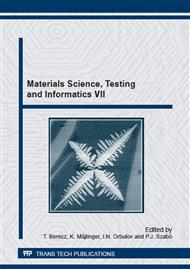p.213
p.219
p.227
p.233
p.239
p.247
p.253
p.259
p.265
The Effect of the Severe Plastic Deformation on the Artificial Aging of the AlMgSi1 Alloy
Abstract:
The AlMgSi1 alloy is generally used in automotive industry owing to its excellent mechanical properties, which can be further improved by applying severe plastic deformation and heat treatment. The dislocation density in the material increases significantly during severe plastic deformation due to the characteristic intensive shear strain. Therefore the motion of dislocations becomes more and more retarded, consequently the strength improves. In addition, the motion of dislocations can be prevented by aging due to formation of coherent precipitations in the metal matrix in order to realize further increasing in strength. In this paper the combined effect of severe plastic deformation and artificial aging treatment on the evolution of mechanical properties was investigated. The samples were subjected to multiple forging (MF) process at room and enhanced temperature. One part of the deformed samples were heat treated at 150°C for different times. The deformed as well as deformed and heat treated samples were investigated by micro hardness testing and X-ray profile analysis.
Info:
Periodical:
Pages:
239-245
Citation:
Online since:
February 2015
Authors:
Keywords:
Price:
Сopyright:
© 2015 Trans Tech Publications Ltd. All Rights Reserved
Share:
Citation:


